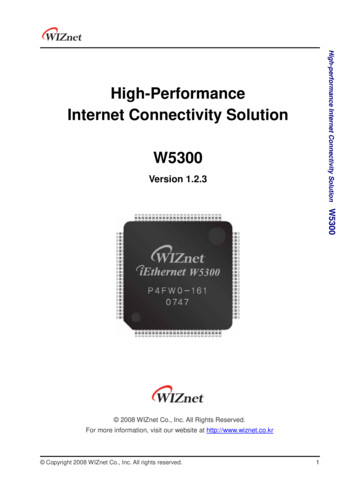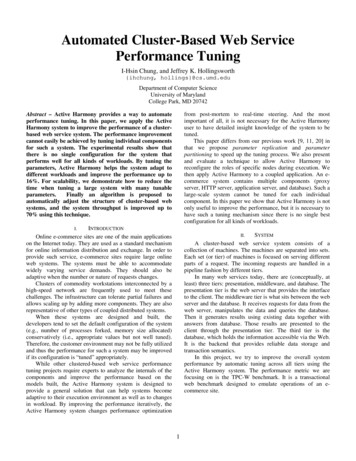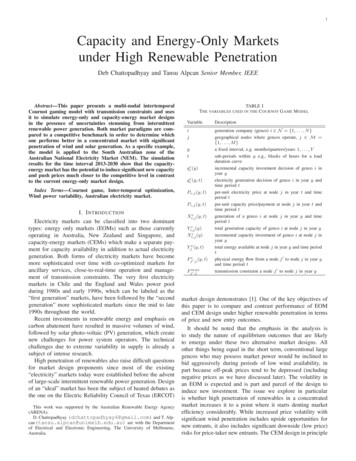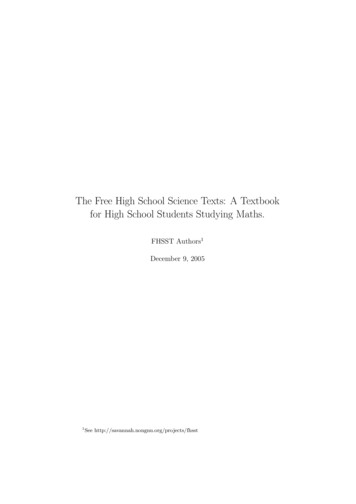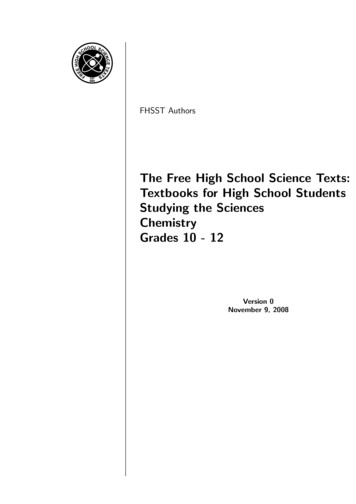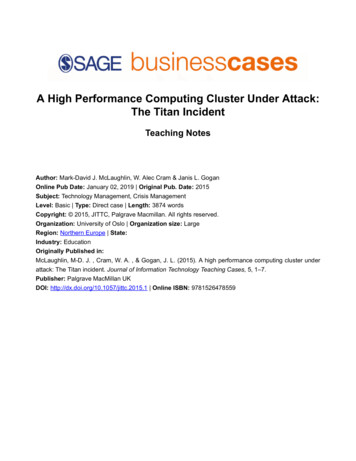
Transcription
A High Performance Computing Cluster Under Attack:The Titan IncidentTeaching NotesAuthor: Mark-David J. McLaughlin, W. Alec Cram & Janis L. GoganOnline Pub Date: January 02, 2019 Original Pub. Date: 2015Subject: Technology Management, Crisis ManagementLevel: Basic Type: Direct case Length: 3874 wordsCopyright: 2015, JITTC, Palgrave Macmillan. All rights reserved.Organization: University of Oslo Organization size: LargeRegion: Northern Europe State:Industry: EducationOriginally Published in:McLaughlin, M-D. J. , Cram, W. A. , & Gogan, J. L. (2015). A high performance computing cluster underattack: The Titan incident. Journal of Information Technology Teaching Cases, 5, 1–7.Publisher: Palgrave MacMillan UKDOI: http://dx.doi.org/10.1057/jittc.2015.1 Online ISBN: 9781526478559
SAGE 2015, JITTC, Palgrave Macmillan. All rights reserved.SAGE Business Cases 2015, JITTC, Palgrave Macmillan. All rights reserved.This case was prepared for inclusion in SAGE Business Cases primarily as a basis for classroom discussionor self-study, and is not meant to illustrate either effective or ineffective management styles. Nothing hereinshall be deemed to be an endorsement of any kind. This case is for scholarly, educational, or personal useonly within your university, and cannot be forwarded outside the university or used for other commercialpurposes. 2020 SAGE Publications Ltd. All Rights Reserved.This content may only be distributed for use within CQ PRESS.http://dx.doi.org/10.1057/jittc.2015.1Page 2 of 21A High Performance Computing Cluster Under Attack: The Titan Incident
SAGE 2015, JITTC, Palgrave Macmillan. All rights reserved.SAGE Business CasesTeaching NotesCase SynopsisAt the University of Oslo (UiO), CERT manager Margrete Raaum learned of a network attack on Titan, ahigh-performance computing cluster which supported research conducted by scientists at various researchinstitutions across Europe. The case describes the incident response, investigation, and clarification of theinformation security events that took place. As soon as Raaum learned of the attack, she ordered that thesystem be disconnected from the Internet to contain the damage. Next, she launched an investigation, whichover a few days pieced together logs from previous weeks to identify suspicious activity and locate the attackvector. Raaum hoped to return to Titan to its prior safe condition and must decide what tasks must still becompleted to validate the systems and determine it is safe to reconnect it to the Internet. She must also consider further steps to prevent, detect, and respond to similar incidents in the future.Target Students/ClassesThis case is designed for an undergraduate or graduate information security (infosec) class that includesstudents with varied technical and business backgrounds. The case supports discussion of technical andmanagerial infosec issues in inter-organizational systems (IOS). For students with more advanced technicalbackgrounds—such as in a network security class—guidance for enhancing the technical content of the discussion is provided. For business students in an IS class, guidance is provided to enhance understanding ofmanagerial issues in ensuring reliable IOS.Teaching ObjectivesThis case deals with four primary topics and one secondary topic:1. Technical activities that help ensure the confidentiality, integrity, and availability of information systems (which collectively we refer to as reliable IS). The case considers aspectssuch as network security, system hardening, authentication, and access controls.2. Incident response, referring to the activities undertaken by organizations during or immediately following a systems-related disaster, outage, or disruption.3. Risk management and governance, particularly related to control mechanisms to preventand detect occurrences that threaten an organization’s ability to achieve its objectives.4. Unique opportunities and challenges associated with ensuring reliable IOS. If an instructor assigns multiple cases in an infosec module, this case might represent a high-complexity inter-organizational context, in contrast to a company dealing with an attack ontheir own systems that does not affect business partners’ systems or data.The task context—support of sophisticated scientific research—gives rise to unique challenges, but is not aprimary focus of the case for purposes of a network security class or an infosec module in a managerial-oriented IS class. However, an instructor teaching in a university whose science or engineering students wouldregister in the class might see opportunities to enrich the discussion by focusing on the special aims of scientists, big data, the large quantities and types of data they analyze, and so on.Although the four primary topic areas are distinct in their focus, several common themes are touched onthroughout the case: general and IOS risks, controls, stakeholder interests.The specific teaching objectives for the case are:Page 3 of 21A High Performance Computing Cluster Under Attack: The Titan Incident
SAGE 2015, JITTC, Palgrave Macmillan. All rights reserved.SAGE Business Cases1. To provide details of a network security attack, including related terminology and an explanation of some specific steps intruders take to gain access to organizational systems.2. To provide students with an understanding of how organizations prepare for and respondto information security incidents.3. To develop students’ skills in applying risk management techniques and assessing governance considerations related to information security.4. To challenge students to consider the complexities of ensuring reliable IOS, and, morebroadly, to consider inter-organizational dependencies in light of information security.Suggested Background Readings for StudentsStudents can be assigned the following readings, depending on the course and students’ technical backgrounds. Each reading can enhance discussion by providing additional context and practical examples to aidin students’ evaluation and interpretation of events in this case.Topic Area and Reading DetailsReading SummaryInformation SecurityKhansa, L. and Liginlal, D. (2009). Quantifying the Benefits of Investing in Information Security. Communications of the ACM.52(11), pp. 113–117.Examines the link between organizational investments in securityand protection from malicious attacks.The RSA 2012 Cybercrimes Trends Report. 1634 CYBRC12 WP 0112.pdfProvides insight into the types ofsecurity threats and into cybercrime perpetrators’ motivations.Incident Response and ManagementWerlinger, R., Muldner, K., Hawkey, K. and Beznosov, K. (2010).Preparation, detection, and analysis: the diagnostic work of ITsecurity incident response. Information Management and Computer Security. 18(1), pp. 26–42.Examines the security practicesassociated with the preparation,detection, and analysis of IT security anomalies.Chen, R., Sharman, R., Rao, R., Upadhyaya, J. (2008). Coordination in Emergency Response Management. Communications ofthe ACM. 51(5), pp. 66–73.Explores of coordination issues,goals, and mechanisms related toemergency response management.Page 4 of 21A High Performance Computing Cluster Under Attack: The Titan Incident
SAGE 2015, JITTC, Palgrave Macmillan. All rights reserved.SAGE Business CasesRisk Management and IT GovernanceTaleb, N. N., Goldstein, D. G. and Spitznagel, M. W. (2009). The SixMistakes Executives Make in Risk Management. Harvard Business Review. 87(10), pp. 78–81.Considers common risk management mistakes, such as relianceon statistics and examining pasthistory.Provides an overview of the relaJohnston, A. C. and Hale, R. (2009). Improved Security through Intionship between IS governanceformation Security Governance. Communications of the ACM.initiatives and information security52(1), pp. 126–129.program success.Suggested Student Case Preparation QuestionsThe following questions are specific to this case and help place students in the position of Margrete Raaum,in order to analyze the contributing factors, key drivers, and subsequent decisions that need to be made.1. Who are the major stakeholders associated with the Nordic Data Grid Facility (NDGF)and UniNETT? What critical resources are stored within the system and what concernsmight stakeholders have regarding these resources?2. How did employees, information security (infosec) processes, and infosec tools inadvertently help the attacker succeed in breaking into Titan?3. What should Margrete Raaum do now? Would you suggest that Titan is ready to beturned on for local access? Is it ready to be reconnected to the computational grid?4. What suggestions would you give Margrete Raaum regarding information security, incident response, and IT governance, in order to better prevent, detect, and respond similarissues in the future?Analysis of Issues1. Who are the major stakeholders associated with the Nordic Data Grid Facility (NDGF) and UniNETT? What critical resources are stored within the systemand what concerns might stakeholders have regarding these resources?The question about stakeholders helps students take a broad perspective when evaluating the case issues,beyond the technical elements of the attack. Thus, the instructor can initiate a discussion that recognizesthe broader impact of information security to include various non-technical participants. The identified NDGFstakeholders could include the following: Leadership (managers, administrators) of the University of Oslo, other participating universities andresearch organizations Scientists at various organizations such as those at UiO and CERN, who analyze data from the supercolliderPage 5 of 21A High Performance Computing Cluster Under Attack: The Titan Incident
SAGE 2015, JITTC, Palgrave Macmillan. All rights reserved.SAGE Business Cases Research funding agencies Information security staff at UiO and other NDGF participating organizationsMany private sector infosec cases focus on protecting customer information and minimizing the financial andreputational costs of incidents. Similarly, this case notes that attackers might harvest users’ credentials fortheir potential value when used to gain access to other systems. However, after identifying the major stakeholders and the resources at risk, students can see a more complex picture. The critical resources that areat risk in this case include user credentials as well as computational resources, data storage capacity, andscientific software and data. The case states that Titan contains ‘271 terabytes of shared disk space, whichsupported scientific research in natural sciences and engineering’. Though the scientific data might seem tobe of limited value to an intruder, tampering with it or deleting it would give rise to significant expense andinconvenience to the scientists who rely on it. Attackers can also use the cluster’s computational resourcesand disk space to host pirated software or launch attacks against other systems.The instructor can introduce the Parkerian Hexad (Exhibit TN1) to help students distinguish among the various resources at risk. The model 1 highlights six key principles of security. The first three—confidentiality (i.e.restricting disclosure of data to authorized parties), integrity (i.e. guarding against improper modification ofdata), and availability (i.e. ensuring timely and reliable data access)—are commonly referred to as the C-I-Atriad. Parker added three other principles, one of which has specific relevance to the case. These principlesare: possession (i.e. physical access to data), authenticity (i.e. confirmation of data’s owner or creator), andutility (usefulness of a particular resource). The utility element plays an especially interesting role in this case,due to the likely low value of the scientific data to the attacker, contrasted to the likely high value of the computational and data storage resources which can be used to launch further exploits, and the user credentialswhich can be sold on the black market.2. How did employees, information security (infosec) processes, and infosectools inadvertently help the attacker succeed in breaking into Titan?This question asks students to consider how infosec professionals use tools and carry out systematicprocesses to ensure reliable IS. Student discussion can focus on sub-optimal infosec elements and controls,as outlined here.EmployeesTwo employee communication issues prevented Rauum from learning about the attack when it first occurred:1. Although the operations team noticed suspicious behavior in the weeks prior to the attackdiscovery, they failed to recognize the implications; instead they thought a scientist wasdoing an experiment. Normally, scientists should not be allowed to modify system-wideresources such as SSH.2. After they issued the vulnerability notification, the operations team believed the CERTteam should have installed the appropriate patch. However, the CERT team was underthe impression that the operations team’s notification was an indication that operationshad resolved the issue. Neither team followed up; both underestimated the potential impact of the vulnerability.Page 6 of 21A High Performance Computing Cluster Under Attack: The Titan Incident
SAGE 2015, JITTC, Palgrave Macmillan. All rights reserved.SAGE Business CasesInformation Security Processes1. Patching: While the attacker gained the initial access to the cluster because of the synchronization of the user database, this is a necessary part of the grid cooperative. Thisattacker gained root access to the server because the Titan cluster and other systems inthe grid were not properly patched and notifications of security advisories were disregarded by the UiO staff. The attack would have been limited to the single compromised account if the patch was properly installed.2. Review of log files: Log files of system and user activities were relied on as a post-incident investigative tool only; unusual patterns or trends in the logs would not be identifiedunless evidence of an attack was identified elsewhere. In other words, even though logfiles can support early detection of an adverse event, they were not used for this purposeat UiO. Also, contrary to best practices the log files were not stored on a separate system,and editing the files from within the system was not restricted.Information Security Tools1. No detection tools were in place to monitor the network for early warnings of threats tosystem integrity or to otherwise reveal anomalies that might have alerted staff to the possibility that an attack was underway.The instructor can capture students’ discussion by noting their comments in two categories: failure to preventthe attack (blocking an attack before it can begin) and failure to detect an attack (identifying that an attack isunderway). This theme continues into the following question, which is concerned with making future improvements.3. What should Margrete Raaum do now? Would you suggest that Titan be immediately reconnected to the computational grid or just brought up for localaccess?In addition to analyzing the nature and extent of the compromise, Raaum’s team needs to return the affectedsystems to normal operations. Her team has reinstalled the local compromised systems; however, there is noindication in the case that she has validated the system or followed up with the NDGF partner universities andresearch organizations to determine the extent of future exposure.In deciding whether to authorize Titan to be reconnected to the computational grid and resume operations,Margarete Raaum has a few options:a. She can resume full operations, but with the risk that an attacker, using credentials compromised at another institution, will regain access to Titan.b. She can resume local operations (just for UiO researchers) and wait to re-enable password synchronization used (to provide access to other NDGF partner organizations) untilthe team is confident the partner universities and labs have secured their systems.c. She can decide not to reconnect Titan and wait to resume until the investigation is complete across the partner network, when she can be more certain that no NDGF systemsand networks remain open to repeated compromise.Page 7 of 21A High Performance Computing Cluster Under Attack: The Titan Incident
SAGE 2015, JITTC, Palgrave Macmillan. All rights reserved.SAGE Business CasesA compromised system should be treated with caution—it is often difficult to detect everything an attacker hasmodified. User data should be carefully reviewed for integrity, and interviews with all key stakeholders shouldbe conducted before returning compromised systems to full operations.4. What suggestions would you give Margrete Raaum regarding informationsecurity, incident response, and IT governance, in order to better prevent, detect, and respond to similar incidents in the future?This is a challenging question that covers a variety of topics. Instructors can focus on particular elements,depending on course objectives and students’ technical backgrounds. The instructor can encourage studentsto consider what Raaum and the UiO can do to reduce the likelihood of future attacks occurring (prevention),improve the ability to identify that an attack is occurring or has recently occurred (detection), and quickly actto limit the damage of an incident (response). This discussion helps students appreciate the complexity ofoverseeing an infosec function, including the distinctions between elements such as incident response and ITgovernance.A table such as the one depicted in Exhibit TN2 can highlight key issues identified by students 2 .In order to theoretically frame students’ responses, the instructor can supplement the classroom discussionwith one or more of the following conceptual models, which can help students think about the temporal aspects of security, incident response, and risk management/governance, while also exposing them to techniques used by information security practitioners.Exhibit TN3 (adapted from case Exhibit 3, Investigation and Remediation Activities) can be used to guide theclass discussion related to improvements to the UiO team’s incident response. The exhibit outlines severalresponse models and provides a brief description of the key elements. Although these models are presentedseparately, they can be discussed in an integrated manner as they all share common themes of risk, control,prevention/detection, and stakeholder interests.General Security PrinciplesWhile the case may seem straight forward, there are several interesting aspects representing general securityprinciples that make this incident a valuable basis for classroom discussion. The interesting aspects of thiscase are not only how the UiO CERT responded to the incident, but in more broadly anticipating and preparing for the challenges that all organizations face in protecting and remediating security incidents, especiallyin an environment where there are complex interdependencies between information systems. This case alsohelps guide discussion regarding general security concepts such as the inherent weaknesses of passwordsand password reuse (the attack vector); organizational issues impacting security posture; and various validapproaches to preventive and remediation efforts.Password-Based SecurityThere have been many high profile cases of passwords being stolen. In October 2013, 150 million email addresses and encrypted passwords were stolen from a server at Adobe Systems 3 ; in August 2014, it wasdiscovered that over 1.2 billion usernames and password combinations were stolen by a Russian crime ringPage 8 of 21A High Performance Computing Cluster Under Attack: The Titan Incident
SAGE 2015, JITTC, Palgrave Macmillan. All rights reserved.SAGE Business Cases4 ; and in October 2014, it was revealed that almost 7 million usernames and pa
system be disconnected from the Internet to contain the damage. Next, she launched an investigation, which over a few days pieced together logs from previous weeks to identify suspicious activity and locate the attack vector.

